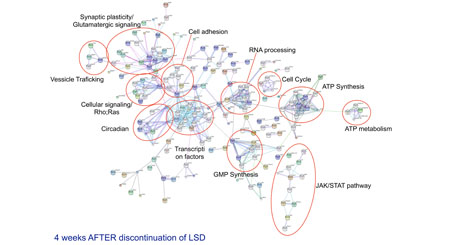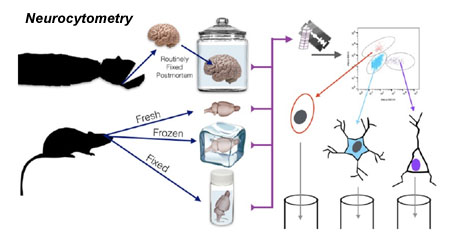The Neuroscience of Psychedelics

Psychedelics activate the target receptor differently than serotonin. This phenomenon is called functional Selectivity. For example, the ability of psychedelics to recruit Gi signaling pathways compared to serotonin may be related to their behavioral effects.
We are currently performing classic receptor pharmacology experiments to identify potentially relevant functionaly selective pathways for not only behavioral effects, but anti-inflammatory effects.

We (and others) have found that psychedelics like LSD and psilocybin influence gene expression in the brain. We have specifically examined gene expression in the medial prefrontal cortex (mPFC) after acute and chronic adminisdtration of drug. Acutely, psychedelics predominantly increase genes encoding proteins involved in syncptic plasticity. These may underlie the ability of psychedelics that we and others have found to rapidly increase synaptic spine density and complexity. Chronic administration of LSD, however, induces a spectrum of aberrant behaviors similar to those in animal models of psychosis. These include anhedonia, increased locomotor activity, and increased reactivity that begin to manifest at around 6 weeks of treatment. By 12 weks of treatment the behaviors are fixed, and persist for at least many months after drug administration is discontinued. We have proposed that this represents a new rodent model of schizophrenia. Several hundred genes are disrugulated weeks after drug discontinuation, and they are significantly enriched for those implicated by others in schizophrenia and bipolar disorder. We are currently combining behavioral and molecular genetic studies in rodents to understand the mechanistic basis of the long-lasting antidepressant effects of certain psychedelics after only a single administration.

In order to examine individual cell types within the brain, we developed new technology called Neurocytometry. This allows us to use flow cytometry to harvest highly purified populations of cell types from fresh, fixed, or frozen brains using routine antibodies for nuclear, cytoplasmic, or extracellular membrane epitopes. Using these techniques, we have found that psychedelics only directly activate about 5% of cortical cells. These cells include excitatory neurons, subsets of inhibitory GABA interneurons, and astrocytes. Interestingly, there are differential effects on the patterns of cellular and molecular activation between brain regions. Together, or data indicate that psychedelics are having complex and differential effects on small subsets of excitatory and inhibitory neurons, and non neurons, that together lead to changes in cortical function ultimately leading to behavioral effects.